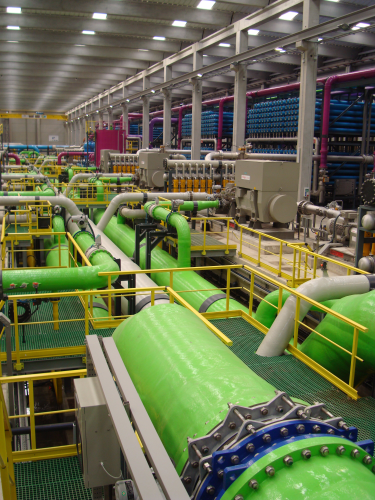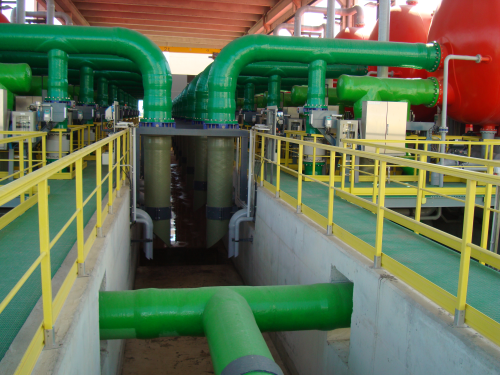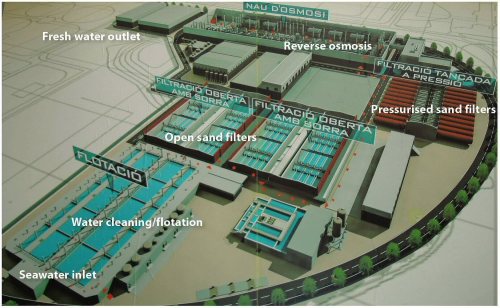


The earth’s surface consists of 70% water. However, less than 1% is accessible fresh water. It is estimated that by 2025 the need for fresh water will increase by 50%. This increase is driven by growing water consumption per head of the world population, by a growing use of water for irrigation in agriculture (especially in dry regions), and also in leisure facilities such as golf courses. In addition, climate change will continue to put pressure on existing water supplies. Without any significant other changes in current water use, and taking into account the pressures mentioned above, by 2025 over 40% of the world population will be suffering severe water stress.
Today, 18 billion m³ of our drinking water is already desalinated. In 2020 this quantity is expected to be 3.5 times greater. The leading technology for desalination plants is reverse osmosis, a filtration process that is used for the purification of water. It works by using pressure to force a salted water solution through a membrane, retaining the salt or solute on one side and allowing the pure water solvent to pass through to the other side. This is the reverse of the normal osmosis process, which is the natural movement of solvent from an area of low solute concentration, through a membrane, to an area of high solute concentration when no external pressure is applied. Today, reverse osmosis is by far the leading technology with growth of 12% per year, slowly replacing the older distillation technology of multi-stage flash (MSF), which is being phased out because of its high energy requirements and high operating costs. (Reverse osmosis is one third the cost of MSF.)
Composite materials
The most commonly used construction material for desalination plants is steel, including carbon steel as well as stainless steel. However, the growing need for fresh water is putting greater pressure on desalination performance. Key industry requirements include a need for larger, easier-to-install water plants, with longer life times and lower maintenance requirements. With a more complex process and an increased use of processing chemicals comes the need for greater chemical and corrosion resistance.
Composite materials are able to replace the existing materials in desalination applications. A good example is the use of glass fibre reinforced plastic (GRP) pipes and fittings. GRP offers a number of key benefits when compared to the traditional materials. For instance, in a large diameter filtration tank, the use of GRP offers the following advantages:
- cost savings on installation and maintenance;
- lower cost of ownership;
- smooth inner liner – lower friction for lower operational energy;
- four times lighter in weight than steel;
- pipe lengths of up to 12 m (all diameters);
- less complexity – fewer joints present fewer opportunities for leakage;
- long, trouble-free lifetime of 50 years; and
- totally corrosion free.
A recent study, which compared a GRP pipe system with a concrete pipe system in a specific application, demonstrated that the concrete solution required more than four times the number of joints, increasing both complexity and the risk of leakage.
GRP has been proven to be particularly suitable for the production of large diameter filtration tanks and high pressure applications such as after pump section pipelines. As chemicals used to clean the installations are very corrosive for metals, GRP’s corrosion resistance is a key benefit. Plant owners will also recognise that this will lead to a significant reduction in maintenance costs as well as increase the life of the installation.
Barcelona desalination plant
The ATLL (Aigües Ter Llobregat) desalination plant in Barcelona, Spain, produces water for urban consumption and is one of the largest seawater desalination plants in Europe with a capacity of 200 000 m³ (200 million litres) per day. This plant uses reverse osmosis technology.
Spanish company Protecciones Plásticas (Protesa) was responsible for the manufacturing, supply and erection of the pipes and fittings in GRP, corresponding to the intermediate and low pressure circuits of the new Llobregat desalination plant. Protesa selected DSM’s Atlac® vinyl ester resins for the piping and fitting parts of the intake and pre-treatment lines, designed and engineered by UTE (Degrémont-Suez-Drace), for high pressure salt removal of the reverse osmosis process.
The scope of Protesa for this project included the pipelines and fittings of the seawater pumping section, sand filters, brine line, raw water pumping, water product line, micro filtration system lines and the suction to high pressure pumps in the pre-treatment process of the plant. Practically all the overhead pipes provided in the plant were fabricated and installed by Protesa by means of chemically welded joints.
The total project covers about 15 km of different pipes: collecting pipes, impulsion pipes and process pipes with diameters ranging from 0.1 m to 2 m.
Atlac resins were selected specifically to provide greater resistance against corrosion by both the existing marine environment and the water treatment process, which involves adding chemical treatment products such as sodium hypochlorite, ferric chloride, sodium bisulphate and/or sulphuric acid during the normal operation of the desalination plant. Atlac was able to meet all the technical requirements, combined with easy process ability and a low peak exotherm. Moreover, the resin offers drinking water contact approval, which was a key Protesa requirement for this particular application.
The GRP pipes and fittings, fabricated using a crossed filament winding process, provide support and coverage to the process lines in the seawater desalination plant. The mechanical specific properties of the Atlac 580, chosen by Protesa for this project, are competitive with other classic materials such as steel, yet they present corrosion proof qualities, unique and inherent to high performance vinyl ester materials. In addition, they significantly lower the direct and indirect costs of the installation.
Changing needs
In a changing world, where fresh water is rapidly becoming a vital commodity, it is imperative that we do everything we can to minimise loss, whilst maximising output and efficiency.
Engineers looking for effective solutions will increasingly find that, thanks to its material properties, GRP is the material of choice. Innovative technologies such as reverse osmosis and dedicated materials such as DSM’s Atlac grades, designed specifically for the desalination industry, are making a vital contribution, ensuring that we prepare for tomorrow’s challenges today.
This feature was published in the March/April 2010 issue of Reinforced Plastics magazine.






